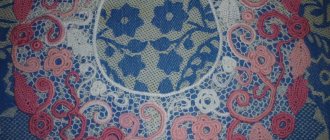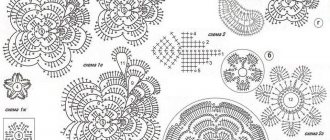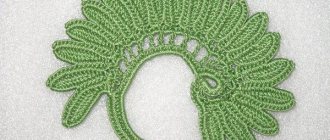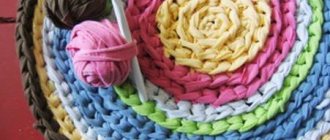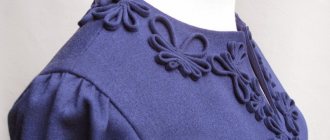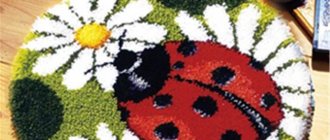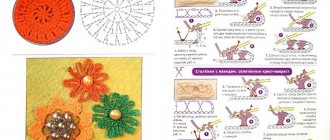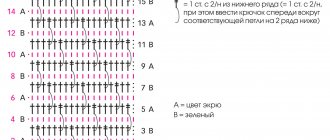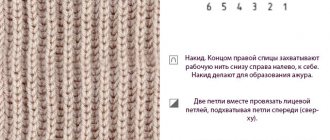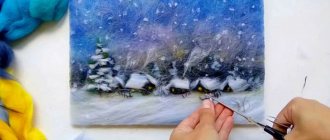Recently, clothes knitted with motifs and elements of Irish lace have become fashionable. Eye-catching things look unusual and beautiful. Unique lace products are highly valued by the most demanding modern fashionistas. You can use knitted details to decorate clothes, handbags, and shoes. It consists of many separately knitted parts connected to each other by a mesh.
The complexity of making the parts of the typesetting lace varies, but all the fragments – both complex and simple ones – look great in the product.
Learning to knit simple patterns for beginners
Craftswomen create lace products from wonderful interweavings of plant patterns, surprising with the unusualness and subtlety of the painstaking work of needlewomen who create openwork crochet compositions. The technique of creating ornaments is varied, there are many ways, but the result is striking in the uniqueness and delicacy of the created pattern. Clothes made using this technique look elegant and extravagant.
To learn how to knit, it’s best to start with simple ones:
- ribbed leaf
- round sheet
- openwork leaf
- simple flower
- flower
- twig with leaves
- cord
Today we will look at the technology for making beautiful petals and leaves on a branch.
By learning simple motifs, you can create the custom pieces you want. The main thing is to have patience, perseverance and a well-developed imagination. If you have all this, you can knit unusual colorful plant compositions.
Color schemes
I suggest studying the diagrams attached below and knitting unique fragments for the desired item.
With six petals
Simple flower
Flower - fan
six petal flower
Volumetric flower
dense flower
Various color schemes
Having learned how to professionally use a knitting tool, you will be able to create any desired product - from a lace napkin to the most fashionable blouse. To do this, you will only need to connect the parts together with a network.
Knitted ribbed leaf and trefoil according to patterns
In Irish knitting, the most famous fragment of the pattern is the ribbed leaf. There are many different schematic drawings for creating leaves, which for some reason scare away novice needlewomen. But beginners should not despair as much as by following the conventions and carefully studying the step-by-step description of the work being performed, everything will work out - you will make beautiful and neat leaves.
Knitting of this element consists of a monotonous thread wound in a half-loop or from melange yarn in two half-loops. The size of the leaf is set by the needlewoman herself, taking into account the unfinished row, creating a narrow leaf shape. Loops are not always counted, at the request of the master.
Instructions for creating a relief sheet
| We cast on 12 air loops. |
| From the second, 9 single crochets, finishing the process with 3 chain loops. |
| The second side of the sheet is identical, at the same time tying the end of the thread. Knitting ends without knitting one loop to the end of the row. |
| One chain stitch is knitted, the workpiece is turned over, and then 11 stitches, single crochet and 3 ch. The other side of the leaf is identical. |
| When knitting the last one, at the end of the row, we grab it in two half-loops to avoid stretching the leaf. |
| Using this method we make the entire leaf. If you do not knit along the column in all rows, you will get beautiful cloves. In the final row, 7 tbsp are knitted in place of the loops. without a crochet. |
| The leaf is connected. Cut the thread, removing the end. |
We create the planned number of identical parts of the future masterpiece.
Crochet shamrock
The next famous motif is the trefoil, used in almost all handicrafts.
To knit it, you need to strictly follow these steps:
- Using a hook of the appropriate size, six air ones are collected and closed into a ring
- Three identical arches are knitted from six similar loops
- The finished arches are tied with two single crochets, sixteen with a double crochet and two more single crochets.
- Having completed the procedure, we cut the fiber, hiding the tail
We get a nice shamrock. A branch with leaves, used in all kinds of homemade products, looks no less nice.
Before we begin to carry out creative manipulations to create a branch with oval leaves, we carefully examine the schematic representation of the presented drawing and consider all further methods in order to avoid making various types of mistakes.
Looking at the picture we see that the process occurs from the bottom up. Let's figure out how to complete the first sheet of a given pattern.
- We collect seven air loops (hereinafter VP ) and ten more.
- We turn this section and knit a connecting loop, one - without a crochet, three - with a crochet, one - without a crochet, one connecting loop, fixing the connecting loop in the seventh loop of the beginning of the chain.
- At the base of the forming leaf, the knitted part is turned from the VP of the leaf being created, and twenty-two half stitches are cast in a circle.
- The work piece is turned, the emerging sheet is tied in a circle with half-columns until the sheet begins to form.
- We collect nine VPs and, in the same way as before, form the next sheet. We monitor the quality of the work procedure; we do not over-tighten or loosen the thread so that the knitted parts keep their shape.
- The workflow then continues as before. The main thing is to carefully read the diagram and correctly count the symbols.
Having further familiarized yourself with the patterns of leaves, you can learn to create other interesting details of lace art.
2.
3.
4.
5.
6.
Varieties of traditional Irish lace
I wrote this article a long time ago when I was trying to figure out what exactly people all over the world call Irish lace. It turned out that not only crocheted lace was popular in Ireland. In different areas of Ireland, different types of lace were knitted, woven and embroidered. But all lace made in Ireland at the end of the 19th century was called Irish and was highly valued in Europe.
Irish lace has gained international recognition due to the fineness of its needlework and complex, distinctive designs. This fishery flourished in Ireland until the end of the 19th century.
Subsequently, the popularity of Irish lace quickly declined. Mainly because Ireland developed poorly industrially, and machine-made lace appeared in the world, which was much cheaper and superior in subtlety to the results of hand-made craftswomen. Handmade lace has become uncompetitive in the market.
By the mid-20th century, the craft of lace making had largely died out and traditional lace making skills were by then maintained by only a few enthusiastic craftsmen in each area of Ireland.
Recently there has been a renewed interest in handmade lace, with many craftswomen in Ireland now making beautiful work in both traditional styles and modern versions of older styles. The process of making lace by hand is still slow and painstaking, which is why handmade Irish lace is still expensive.
Types of Irish lace
There are several traditional Irish types of lace. They differ, first of all, in their manufacturing technology: some are made with a needle using thin fabric - muslin, some are made by crochet from linen, silk and cotton yarn. But any work of Irish lacemakers today is not only of interest to many, but is also in consumer demand. In addition, today in Ireland you can buy real antique lace, many of which have been preserved in their original form.
Irish crochet lace collar and cuffs.
Irish Crochet Lace (Irish crochet lace)
Irish crochet lace collars and trims.
This style of lace is very typical of Ireland: with patterns of flowers and leaves, built in two or three layers, which is why it has a three-dimensional effect. Entire items of clothing, such as christening robes, cardigans, capes and even wedding dresses, were made from this type of lace.
Irish crochet lace clothing
The origins of Irish Crochet Lace are not certain, but they were probably brought to Ireland by nuns who learned the technique of making such lace in France. Often, the motifs in such lace were knitted by several craftswomen who specialized in making one type of motif (for example, one knitted only leaves, another only knitted roses). The assembly of the canvas was carried out by another person. There is an opinion (historical information by Iya Churakova) that Irish Crochet Lace was invented by Mademoiselle Riego de Blancardier, the daughter of a Franco-Spanish nobleman and an Irish woman. It was she who figured out how to make lace, which resembled Venetian lace, but could be crocheted, which greatly speeded up production. A piece of lace that required at least two hundred hours to make with a needle could be knitted in just 20 hours. In 1846, Riego de Blancardier published the first book of Irish crochet patterns. The new technique spread very quickly, and soon entire families were busy knitting lace, which was in great demand in Europe. Crochet motifs were ubiquitous in Ireland. Crochet Irish lace has become an independent brand. The most famous fashion houses purchased lace for dresses, capes, capes and even umbrellas.
In the 1950s and 60s, Irish fashion designer and couturier Sybil Connolly, whose work was internationally famous and popular in those years, primarily among wealthy people in the United States, used Irish Crochet Lace in the designs of many of her clothing products and took personal responsibility for the revival of this craft in Ireland.
Sybil Connolly
Carrickmacross Lace
Lace, which was born in Carrickmacross. This style of lace owes its existence to Mrs. Gray Porter, the wife of the local church rector. She brought home to Ireland samples of lace from Italy, where she traveled with her husband on their honeymoon. Later, in search of a solution to the problem of providing work for poor local women, she created lace-making classes, where Italian lace motifs and designs were initially copied. Other wealthy landowners in the area followed suit and during the lean years, lace making became the only source of income for the poor people of Carrickmacross.
Lace quickly transformed from the Italian style into something special and recognizable. The reason for this was the new technology for its production. The lace pattern was obtained as a result of needle embroidery on a muslin fabric connected to a dense fabric base, after which the fabric base was cut out, and the thin muslin and relief embroidery remained as an openwork fabric:
Carrickmacross Lace Demonstration Nora Finnegan at the Kenmare Lace & Design Center
While many other styles of lace fell into oblivion in the early 20th century, Carrickmacross lace remained in demand, primarily thanks to the craftswomen of the St. Louis Convent, where hundreds of fans of this lace are still trained in this craft. Now craftswomen produce this type of lace, often for members of the royal house and on orders from leading couturiers and designers of the world. For example, both Princess Diana's wedding dress and the wedding dress of Prince Harry's bride, Catherine Middleton, Her Royal Highness the Duchess of Cambridge, were trimmed with real Carrickmacross lace.
Lady Di's wedding dress trimmed with antique Karikmacross lace.
Catherine Middleton's wedding dress with classic Caricmacros lace.
Clones Lace
These laces appeared in the town of Clones, thanks to Cassandra Hand, the wife of the head of the local church, who taught how to knit them in order to provide local work for the poor parishioners of the church.
Cassandra Hand
Cassandra Hand Center Clones,Co.Monaghan Ireland (Cassandra Hand House Museum in Clones).
The original design of this lace was a copy of Venetian lace. The only difference is that in Venice such lace was made of needles - the motifs were embroidery on fabric. But making crocheted motifs significantly reduced the time needed to produce these laces. To make the imitation of the Venetian miracle look as close as possible to the original sample, the lace was knitted from very thin threads using a very thin hook made from a needle.
Characteristic of Clones Lace is the use of clones knots, created by turning the hook several times around the thread. This creates a special highlight that is characteristic of Clones lace.
Marie Treanor demonstrates the technique of making Clones knots
Traditional Clones Lace did not die out in the town of Clones in the early 20th century, as it did in other places. At the end of 1940, local lace manufacturers were knitting dresses for Queen Mary, a big fan of this type of lace. From her coronation dress to her lingerie, the Queen's entire outfit was decorated with lace from Northern Ireland.
Antique Clones Lace Products.
The decline in the production of this lace began after the Great Patriotic War - the turnover of the linen industry sharply decreased, which led to a lull in the production of Clones Lace. The art of making Clones Lace was revived in the late 1980s by craft enthusiast MarieTreanor.
Currently, she is very active in popularizing this lace: she holds meetings for lacemakers, gives training lessons, writes Clones Lace books, and communicates very kindly and responsively on the Internet with everyone who is interested in this type of needlework.
Kenmare Lace
The history of Kenmare lace dates back to 1860, when the buildings of the Priory and Church of the Holy Cross in the town of Kenmare were completed. Along with this joyful event came the realization of the fact that there was almost no other work in the city - only trade. There was absolutely no paid work for women in the city. Already by 1864, workers and their families began to experience the most difficult times: poverty and hunger. This plight was the impetus for the nuns of Poor Clare, under the leadership of Mother Abbess O'Hagan, to create a school of needlework to help both those in need and themselves, establishing a workshop in the monastery building. There, young girls were engaged in the production of lace for church clothes and church utensils, wood carving, and made leather goods.
Initially, the goods made in this workshop were sold at a local hotel to wealthy tourists from England and Dublin who came here on vacation in the summer. By 1869, the triumphant march of Kenmare Lace began around the world: it was so elegant, delicate, with an original design and virtuoso execution that it became known as the “Point d'Irelandaise”. It could already be bought in both Paris and London. At the Cork Exhibition in 1883, Kenmare lace was awarded medals for its excellence in workmanship. There was great interest in this exhibition in those days in the art world. Kenmare Lace became very popular, primarily among church ministers. Many bishops and cardinals ordered their clothes from the monastery in Kenmare. It must be said that to this day lace (not only Irish, of course, but handmade) in the clothing of church ministers is very popular:
The manufacturing technology of Kenmare Lace is quite complex: it is needle lace, which is first embroidered on two layers of fabric, and then a denser fabric - the base is cut out between the embroidered fragments, which are connected by thin brid stitches.
Nora Finnegan demonstrates the technology of making Kenmare lace and talks about the history of its origin.
To this day, real Kenmare lace is highly valued. How much do you think such a fragment could cost?
You will definitely be wrong. On the Kenmare Lace website this composition is sold for... €2,275.00.
Today, the technology for making this type of lace is preserved thanks to enthusiasts and lovers of the history of Ireland, its culture and traditions. People like Nora Finnegan, director of the Kenmare Lace and Design Centre.
Nora Finnegan
Kenmare Lace and Design Center building.
The center is located on the second floor of this building. This is not only a museum. It is a meeting place for lacemakers from all over the world. When it comes to the lace that Nora demonstrates, language barriers disappear. The art and craft of lace making is itself a form of communication. This is where Kenmare lace is stored, made, displayed and sold. Here you can also buy materials for making lace. The first thing that catches your eye when entering the center is samples of antique lace from the Kenmare Clarice Convent.
Youghal lace
Yule (Yougal) lace differs little from Kenmare lace, because these areas are located not far from each other, and the developers of these types of lace initially learned from each other. But still there are differences. The debate about which of these laces appeared first and what their distinctive features are continues to this day. You can find diametrically opposed information in different sources.
But Yougal lace originated in the convent of Yougal, County Cork, where nuns developed their own style of lace and taught it to the local people to help them survive the potato famine of the 1840s. Some sources have the following information: “Yougal lace was born in poverty and famine of 1845-1847. Mother Mary Ann Smith discovered a small piece of old Italian lace in the convent. She took it apart, studied every stitch and developed a technique for reproducing them..."
It appears that Yougal lace actually came from Venetian lace. But Yougal has its own distinctive features: its designs often use flowers, berries and fruits native to the region. This is truly authentic “Irish” lace.
Yougal lace is finer as it originally competed with the even finer Belgian lace and did not travel far beyond the British Isles for many years. Therefore, Yougal lace is very difficult to find today and these laces are extremely rare in collections around the world.
In 1960, the last nun who owned all the secrets of producing this lace died. But books on needle lace have survived, thanks to which the Yougal lace making technique has survived to this day.
Inishmacsaint lace
Inishmacsaint is a small town where a unique style of lace making flourished in the late 1900s. Initially, the lace was very similar in manufacturing technology to Kenmare lace.
Perhaps the significant difference was the thicker threads that were laid under the embroidery, which made all the lace more voluminous and expressive. Later, its own special, characteristic design appeared: stylized flowers and buds in a lace pattern, which are difficult not to recognize:
Today, very few local enthusiasts are engaged in making this type of Irish lace. Inishmacsaint lace is so difficult to make and rare to sell that the cost of antique Inishmacsaint lace and those made today are the same.
Limerick Lace
One of the earliest known Irish styles, Limerick Lace was a commercial enterprise from the start, founded by Charles Walker as a center for the education and training of lacemakers around 1830. By 1850, Limerick Lace became popular and to this day this lace is appreciated by fashionistas throughout Europe.
This is an extremely light and thin lace with floral designs embroidered in tiny stitches on a fine mesh base. Usually the mesh was stretched over a frame for embroidering a design on it. But there is also a technology for embroidery without a frame, where a thin mesh is attached to a durable fabric base.
Limerick Lace
Sandra Finnegan demonstrates Limerick Lace technology.
These laces are still produced today, but during the period of Charles Walker's business, large quantities of these laces were produced, with the result that they are still quite widely available today.
Connecting knitted parts
Having learned to knit various fragments, they can be connected to each other:
- with a needle
- grabbing the loops of the last row of two parts
- using an irregular mesh, honeycomb mesh or fillet mesh
- knitting a mesh separately and sewing details onto it
Ready-made miniature motifs are used to decorate blouses, skirts, cardigans, hats, and handbags; from them you can create chic and beautiful paintings, panels, or create a fancy napkin that decorates the living room.
To recreate unique things with a charming weaving technique, you need to have developed imagination, patience and a great desire to create without limits.
We knit amazing patterns of motifs in master classes
The method of working in Irish technology is distinguished by assembling a product from several separately connected “puzzles” connected to each other by a mesh. The main thing is to feel the work being created, select the correctly combined shades of threads, and combine fragments correctly. Having a creative approach to performing interesting and exciting work, the result will please the craftswomen with a masterpiece. Having carefully studied the process of knitting individual motifs and mesh, beginning knitters will be able to knit their first composition.
Cords and curls, flowers and petals connected by a mesh look great in lace. On clothes the curls look a little better in better light. Needlewomen use the original curled yarrow.
Video lessons or how to knit yarrow mk.
Let's look at step-by-step instructions for creating a yarrow motif. The element is performed using a bourdon - a thread in three folds. The same thread is used as the working thread.
| Motif illustrations | Step-by-step instruction |
| For bourdon we dial 18 s. b. n., forming a ring. | |
| We continue to dial 60 s on the bourdon. b. n. | |
| Turn the knitting, pulling the bourdon threads tighter and knit 20 tbsp. b. n., laying the bourdon over the loops of the underlying row. | |
| Knitting the last loop, we tighten the bourdon, giving the shape of the part. | |
| The bourdon thread is set aside. We knit 3 in. p., 1 tbsp. With. n., 2nd c. p. We do this in this way before the leaf begins to round and along it. | |
| The knitting is turned, we tie the arches with three single crochets. Bourdon remains aloof. | |
| We reach the end, turn the product over, knit 15 tbsp on the bourdon. b. n. | |
| The work is turning around. we also do bourdon, 2 st.b.n., 2 half-columns, 7 st.s.n., 2 half-st.b.n., 2 st.b.n. | |
| We skip 2 loops of the underlying row, knit 1 tbsp, the work is turned, placing the budon on top of the petal, knit 8 tbsp. b. n. | |
| Next, add 7 tbsp to the bourdon. b. n. | |
| The work is rotated, the next petal is formed. The procedure is repeated until the end of the row. It turns out to be a beautiful curl. |
Having learned how to perform one fragment, we begin to perform other parts. Following the schematic images, we create the curls, leaves, and caterpillars we like. Yarrow diagram for beginners
Often, when creating lace dresses, all kinds of cords are used together with floral ones to emphasize the created ornament. One of these is the caterpillar cord.
We invite you to see a detailed step-by-step description of the thick braid used in creativity.
| Illustration | Description |
| An air loop is knitted, the hook is inserted under the thread of the first knot, the thread is brought out and a loop is made. | |
| There are already two pieces formed on the hook, through which the third is pulled. | |
| Let's turn the work around. | |
| Turning the knitted piece, we find two threads. | |
| We create a loop through the discovered threads. There are two on the working tool. | |
| Let's tie two loops together. | |
| We are expanding the work. | |
| We pull one loop through two threads. | |
| The work process is repeated. We tie a lace of the required length. |
Recommendations for a large-scale project
Having mastered a variety of joining techniques, you can begin to form a solid canvas, which, subsequently, will replenish your wardrobe in the form of an elegant little thing. To do this, you must follow a number of basic rules.
You should start with simple motives, trying to connect an element every day. If you immediately want to make components for clothing, you will need a pattern for the future product that fits perfectly to your figure. You can design it yourself, or take a ready-made one from specialized magazines.
The best thing is to give preference to one that has already proven itself in ordinary sewing. The completed layout can be created from a disposable tablecloth or stiff tulle, assembled together and tried on. This is necessary to ensure a good silhouette fit; if any shortcomings are identified, they need to be corrected.
Patchwork - technique and master class for sewing stylish and beautiful sewing with your own hands (80 photos)- Tilda doll - a master class in sewing toys with your own hands. 125 photos of the best toy models
How to make a car out of paper: step-by-step description of how to quickly and easily build a high-quality car (75 photos + video)
ADVICE. The pattern should be increased by 1 cm on all sides, since when completed tightly it will shrink.
Experienced craftswomen recommend, immediately after completing each link, to thread the protruding end of the thread. This maneuver is performed with the blunt end of a knitted needle on the wrong side. In addition, it is recommended to tie it with a thinner thread.
The edges that will fall into the area of the shoulder and side seams, as well as darts, are not made even - in this case, the finishing seams will not be noticeable.
Next, you can’t do without pre-processing. There are two ways to do this. The first is to steam with an iron. In the second case, it is acceptable to wet it with water and leave it to dry on a flat surface. If the motif is created with lurex fiber woven in, it must be secured with pins, otherwise it will curl up.
When all the components are ready, the creator will only have to arrange them on the pattern in the desired order, without spending additional time and effort.
- Paper toys - diagrams, ideas and options for making various toys with your own hands (110 photos)
Dymkovo toy - modern collections, their creation and features of making Dymkovo toys (115 photos and videos)
Knitting openwork patterns - diagrams and step-by-step master class on how to knit an openwork pattern quickly and easily (95 photos + video)
When the picture of the pattern is clear and pleasing to the eye, all the details are turned face down and pinned with pins or sewn with thread, whichever is more convenient. Components in contact with each other must be carefully sewn together.
At the final stage, everything is connected by a mesh created by thinner yarn and, accordingly, a smaller tool.
ATTENTION. In a multi-color product, it is recommended to take no more than three shades of the palette, which should combine well with each other.
More detailed useful tips can be seen in the video tutorial.
This type of creativity, which arose in Ireland during the famine years, was appreciated by representatives of high fashion. One of them was Jean-Paul Gaultier. At the beginning of the 2000s, his models, with an attractive note of mystery, were shown on the most extravagant catwalks, causing delight and interest.
Perhaps his work will inspire you to sculpt your own piece of art, since the motifs can be used to create a huge variety of unique accessories and outfits. These can be handbags, umbrellas, hats, collars, or wardrobe items: short cardigans, dresses or decorative inserts in them, tops, jackets, summer items.
Irregular mesh for knitting in video tutorials
Fastening fragments with a net is a fairly simple type of knitting, which consists of laying out parts on a pattern, filling the empty space with fillet mesh.
Read also: “Irregular mesh in Irish lace”
A void of unequal size is filled with an irregular network.
The procedure is simplified by knitting a mesh pattern and attaching finished elements to it. Most lace products are assembled using an irregular mesh.
Crochet instructions, its elements and motifs
The pieces of Irish lace are connected by an irregular network. We first attach the sections connecting the fragments with stitches, fill the space with an asymmetrical network created by changing air arches and columns with different numbers of crochets.
The prepared motifs are placed on a pattern placed on a foam rubber backing and secured with tailor's pins so that the fabric does not wrinkle. They are laid out face down.
Having settled on the space between the elements, we knit an asymmetrical mesh. To do this, the hook is inserted from above into the warp, catching the working thread and pulling.
We hook the short end of the thread and pull it through the resulting loop. The thread is secured by pulling up the long working end and tightening the knot. The tail is hidden in the canvas.
We collect 4 air loops.
To determine the location of fixation, apply a stretched thread to different parts and find the junction by knitting a double crochet stitch into it.
Then 2 air loops.
Now a stitch with three crochets.
Since the element is located too close, a double crochet is knitted, clinging to the base.
Next is an air arch of four loops.
We perform a double crochet stitch.
We hook two air loops to the base.
Let's knit an air arch of four loops.
We knit a double crochet stitch.
This technique fills the empty space, alternating air arches and columns with different amounts of double crochet.
Having finished the work, we cut the thread with scissors and hide the tip between the posts.
Using this method, lace puzzles are assembled together.
Having learned the simplest knitting techniques, new knitters will be able to create unique, extraordinary products themselves, knitted in the style of Irish lace, and conquer the modern fashion world with excellent clothes. How individual lace fragments are knitted can be clearly seen in the video below.
How does the technique of Irish lacemakers differ?
In the 21st century, with the help of modern technologies, you can create almost any lace. Now materials with lace are not considered an item of luxury and wealth, but are a simple mechanical decoration of clothing. It is possible to recreate needle, shuttle and bobbin lace, but Irish lace (IL) is not yet capable of reproducing even the best equipment.
Irish lace technique
The technique of Irish lacemakers is special and can only be done by hand. Volumetric knitting is done using a thin hook. Assembling many individual components with a needle is painstaking work, usually done with the help of a mannequin. The lacemaker tries to make a single composition so that it fits perfectly and there are no visible seams.
Classic Irish lace
Each craftswoman specialized in creating individual motifs. One wove flowers, another made patterns, the third connected the parts together. Also, men, old people and children were often involved in this type of needlework - and they were quite good at lace making.
You might be interested in what types of cellular tissue there are, features of the English cell
